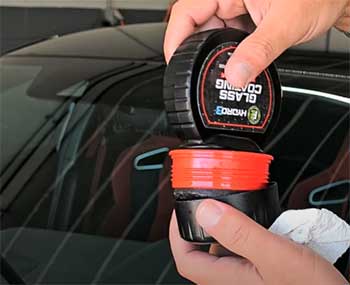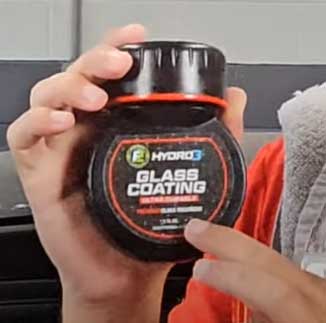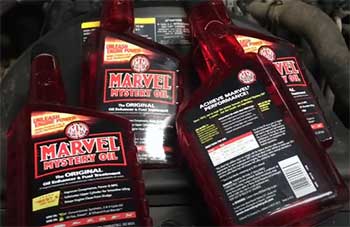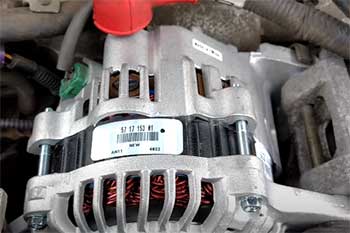If you’re tired of battling with rain-soaked windshields and streaky wipers, let me introduce you to Hydro3 Glass Coating. This product has transformed my driving experience, and I’m confident it can do the same for you.
Imagine cruising down the highway in a downpour without needing your wipers—sounds too good to be true, right?
Well, Hydro3 makes it possible. Stick around as I share my personal experience with this coating, its pros and cons, how it stacks up against competitors, and tips to keep it working like new. By the end, you’ll know exactly why this product deserves a spot in your car care routine.
My Experience Using Hydro3 Glass Coating
When I first heard about Hydro3 Glass Coating, I was skeptical. I’ve tried countless products over the years—some expensive ceramics, others cheap quick fixes—and none seemed to live up to their promises. But something about Hydro3 caught my attention.

Maybe it was the promise of long-lasting protection or the fact that it’s made in the USA. Either way, I decided to give it a shot.
The first thing I noticed was how easy it was to apply. The built-in applicator made the process seamless, and within five minutes, my windshield had a fresh layer of protection. After letting it cure for 15 minutes, I wiped it off with a microfiber cloth.
To my surprise, there were no streaks or hazy spots—just a crystal-clear finish. That night, I drove home in a light drizzle, and the water just slid off my windshield like magic. No wipers needed. It was a game-changer.
Over the next few months, I put Hydro3 through its paces. Living in an area with frequent rain, I was curious to see how long it would last. Six months later, it’s still performing like new.
Even at highway speeds during heavy downpours, the water beads up and flies off effortlessly. Bugs don’t stick either, which is a huge plus if you’ve ever spent hours scrubbing them off after a road trip.
Pros of Hydro3 Glass Coating
Hydro3 Glass Coating has several standout features that make it worth considering. Let’s break them down into categories to give you a clearer picture of what makes this product so special.
- Exceptional Durability
One of the biggest selling points of Hydro3 is its longevity. Unlike other coatings I’ve used, this one doesn’t wear off after a few weeks. In my experience, it lasted a solid six months before I noticed any decline in performance.
Even then, it wasn’t a dramatic drop-off—it just required reapplication to bring it back to peak condition. For someone who drives daily, especially in rainy conditions, this kind of durability is a lifesaver.
What sets Hydro3 apart from cheaper alternatives is its resistance to environmental factors. Whether it’s heavy rain, dirt, or bugs, this coating holds up remarkably well. I’ve driven through muddy roads and bug-infested highways, and my windshield stayed clean and clear.
- Enhanced Visibility

Visibility is crucial when driving, especially in bad weather.
Hydro3 excels in this area by increasing the water contact angle on your windshield.
What does that mean for you?
Simply put, water beads up and rolls off instead of smearing across the glass. This not only improves clarity but also reduces glare, making nighttime driving safer.
During one particularly stormy night, I didn’t even need to turn on my wipers. The water just flew off my windshield as I drove, giving me an unobstructed view of the road ahead.
If you’ve ever struggled with streaky wipers or foggy windows, you’ll appreciate how much of a difference this makes.
- Ease of Application
Another major advantage of Hydro3 is how user-friendly it is. The built-in applicator eliminates the need for extra tools, and the entire process takes less than five minutes. Applying the coating is as simple as wiping it on, letting it cure, and buffing it off.
I’ve used other products where the application process felt like a chore, but Hydro3 is refreshingly straightforward. The instructions are clear, and the results are consistent. Plus, one bottle covers multiple vehicles, which is great if you have more than one car or want to share it with friends.
- Made in the USA
As someone who values quality and craftsmanship, I appreciate that Hydro3 is made in the USA. This ensures that the product meets high standards of excellence. It’s not just about patriotism—it’s about knowing that you’re getting a reliable, well-made product that’s been tested and refined locally.
Cons of Hydro3 Glass Coating
While Hydro3 has many strengths, it’s important to acknowledge its limitations. Here’s a closer look at some of the downsides I encountered during my time using this product.
- Temperature Restrictions
One issue I ran into was applying Hydro3 in colder weather. The instructions clearly state that it shouldn’t be used below 40°F, which can be a problem if you live in a northern climate. I had to wait for a warmer day to apply it, which wasn’t ideal.
For those living in areas with harsh winters, this could be a significant drawback. If you’re planning to use it year-round, you’ll need to time your applications carefully to avoid temperature-related issues.
- Buffing Challenges
While applying the coating is straightforward, removing the excess can be a workout. I went through several microfiber cloths trying to get a streak-free finish, and even then, I noticed some hazy spots later. It’s not a dealbreaker, but it’s something to be aware of.
Travel with a spare cloth afterward, because you’re bound to notice some hazy spots you missed the next time you get some fog or dew on your glass. While this might sound like a minor inconvenience, it can be frustrating if you’re looking for a completely hassle-free experience.
- Annual Reapplication
Although Hydro3 is durable, it’s not a permanent solution. The coating requires annual reapplication to maintain its effectiveness. For some people, this might feel like an unnecessary expense or hassle. If you’re looking for a one-time fix, this might not be the product for you.
That said, the benefits outweigh the drawbacks for most drivers. The annual cost is reasonable compared to premium ceramic coatings, and the performance is well worth the effort.
Tips For Longevity of Hydro3 Glass Coating
To get the most out of Hydro3, proper maintenance is key. Here are some tips to ensure your coating lasts as long as possible.

- Clean Your Windshield Before Application: Start by cleaning your windshield thoroughly before applying the coating. Any dirt or grime left behind will affect the bond, reducing its effectiveness. Use a glass cleaner specifically designed for automotive use to avoid leaving residues. I recommend using a clay bar to remove any embedded contaminants. This step might seem tedious, but it makes a noticeable difference in how well the coating adheres to the glass.
- Avoid Abrasive Materials: Once applied, avoid using abrasive materials or harsh chemicals on your windshield. These can strip away the coating and shorten its lifespan. Instead, opt for gentle cleaners and soft cloths. I also recommend keeping a spare microfiber towel in your car to wipe off any hazy spots that appear after fog or dew. Regular maintenance like this helps preserve the coating’s hydrophobic properties.
- Reapply Annually: Reapplying the coating annually is crucial for maintaining its performance. Mark your calendar or set a reminder so you don’t forget. Trust me, the results are worth the effort. If you live in an area with extreme weather conditions, you might need to reapply it more frequently. Pay attention to how your windshield performs over time and adjust accordingly.
How Hydro3 Compares To Other Brands?
I’ve tried my fair share of glass coatings, so I feel qualified to compare Hydro3 to some of the big names out there.
- Hydro3 Vs. Rain-X: Rain-X is a popular choice for many drivers, but it doesn’t hold a candle to Hydro3 in terms of longevity. I’ve found that Rain-X wears off after a few weeks, especially if you drive frequently in harsh conditions. Plus, it can damage rubber seals, which Hydro3 doesn’t do.
- Hydro3 Vs. Ceramic Coatings: High-end ceramic coatings offer excellent performance but come with a hefty price tag. Hydro3 delivers similar results at a fraction of the cost. Sure, it may not last as long as a professional-grade ceramic coating, but for the average driver, it’s more than sufficient.
- Hydro3 Vs. Aquapel: Aquapel is known for its durability, but it’s notoriously difficult to apply. Hydro3 strikes a balance between ease of use and effectiveness, making it a better choice for DIY enthusiasts.
Also Read: Is Teeporus Car Coating Spray Worth It?
Frequently Asked Questions (FAQ)
Absolutely. A quality glass coating like Hydro3 improves visibility, reduces the need for wipers, and protects your windshield from damage. For anyone who drives regularly, especially in wet conditions, it’s a worthwhile investment.
Start by cleaning your windshield with a high-quality glass cleaner. Shake the Hydro3 bottle well, then apply a thin, even layer using the built-in applicator. Let it cure for 15 minutes, then buff off the excess with a microfiber cloth.
Some downsides include temperature restrictions during application, the need for annual reapplication, and potential difficulty in buffing. However, these are minor inconveniences compared to the benefits.
With proper maintenance, Hydro3 can last up to a year. In my experience, it performed flawlessly for six months, even in heavy rain.
Final Thoughts
After months of testing, I can confidently say that Hydro3 Glass Coating is one of the best products I’ve used. It’s durable, effective, and easy to apply, making it a standout choice for anyone looking to enhance their driving experience.
Don’t let rainy days ruin your commute—give Hydro3 a try and see the difference for yourself.

